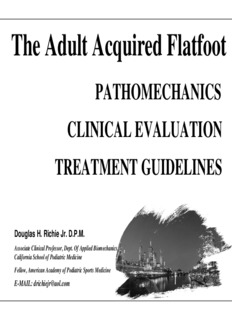
The Adult Acquired Flatfoot - Richie Brace PDF
Preview The Adult Acquired Flatfoot - Richie Brace
The Adult Acquired Flatfoot PATHOMECHANICS CLINICAL EVALUATION TREATMENT GUIDELINES Douglas H. Richie Jr. D.P.M. Associate Clinical Professor, Dept. Of Applied Biomechanics, California School of Podiatric Medicine Fellow, American Academy of Podiatric Sports Medicine E-MAIL: [email protected] Studies of AFO Treatment of Adult Acquired Flatfoot Chao W, Wapner KL, Lee Th, Adams J, Hecht PJ. Nonoperative management of posterior tibial tendon dysfunction. Foot Ankle Int. 17(12): 736-41, 1996. Augustin JF, Lin SS, Berberian WS, Johnson JE. Nonoperative treatment of adult acquired flatfoot with the Arizona Brace. Foot Ankle Clin. 8 (3): 491-502, 2003. Alvarez GR, Marini A, Schmitt C, Satlzman CL. Stage I and II posterior tibial tendon dysfunction treated by a structured nonoperative management protocol: an orthosis and exercise program. Foot Ankle Int. 27 (1): 2-8, 2006. Lin JL, Balbas J, Richardson EG. Results of non-surgical treatment of stage II posterior tibial tendon dysfunction: a 7- to - 10 year follow up. Foot Ankle Int 29 (8): 781-786, 2008 Krause F, Bosshard A, Lehmann O, Weber M. Shell brace for stage II posterior tibial tendon insufficiency. Foot Ankle Int 29 (11): 1095-1100, 2008. Gliding resistance of the posterior tibial tendon Foot Ankle Int. 2006 Sep;27(9):723-7. Uchiyama E, Kitaoka HB, Fujii T, Luo ZP, Momose T, Berglund LJ, An KN.Department of Anatomy, Sapporo University, Sapporo, Hokkaido, Japan. BACKGROUND: Abnormal gliding of the posterior tibial tendon may lead to mechanical trauma, degeneration, and eventually posterior tibial tendon dysfunction. Our study analyzed the gliding resistance of the posterior tibial tendon in intact feet and in feet with simulated flatfoot deformity. METHODS: An experimental system was developed that allowed direct measurement of gliding resistance at the tendon-sheath interface. Seven normal fresh-frozen cadaver foot specimens were studied, and gliding resistance between the posterior tibial tendon and sheath was measured. The effects of ankle and hindfoot position and the effect of flatfoot deformity on gliding resistance were analyzed. Gliding resistance was measured for 4.9 N applied load to the tendon. RESULTS: Mean gliding resistance for the neutral position was 77 +/- 13.1 (x10(-2) N). Compared to neutral position, dorsiflexion increased gliding resistance and averaged 130 +/- 38.9 (x10(-2) N), and plantarflexion decreased gliding resistance and averaged 35 +/- 12.6 (x10(-2) N). Flatfoot deformity increased gliding resistance compared to normal feet, averaging 104 +/- 17.0 (x10(-2) N) for neutral, 205 +/- 55.0 (x10(-2) N) for dorsiflexion, and 58 +/- 21.3 (x10(-2) N) for plantarflexion. CONCLUSIONS: The findings indicate that patients with a preexisting flatfoot deformity may be predisposed to develop posterior tibial tendon dysfunction because of increased gliding resistance and trauma to the tendon surface. Effects of foot orthoses on the work of friction of the posterior tibial tendon. Clin Biomech (Bristol, Avon). 2009 Nov;24(9):776-80. Epub 2009 Aug 22. Hirano T, McCullough MB, Kitaoka HB, Ikoma K, Kaufman KR. Department of Anatomy, Sapporo University, Sapporo, Hokkaido, Japan. Biomechanics Laboratory, Division of Orthopedic Research, Mayo Clinic, Rochester, MN 55095, USA. BACKGROUND: Posterior tibial tendon dysfunction is a significant contributor to flatfeet. Non-operative treatments, like in-shoe orthoses, have varying degrees of success. This study examined changes to the work of friction of the posterior tibial tendon under three conditions: intact, simulated flatfoot, and flatfoot with an orthosis. It was hypothesized that work of friction of the posterior tibial tendon would significantly increase in the flatfoot, yet return to normal with an orthosis. Changes to bone orientation were also expected. METHODS: Six lower limb cadavers were mounted in a foot simulator, that applied axial and a posterior tibial tendon load. Posterior tibial tendon excursion, gliding resistance, and foot kinematics were monitored, and work of friction calculated. Each specimen moved through a range of motion in the coronal, transverse, and sagittal planes. FINDINGS: Mean work of friction during motion in the coronal plane were 0.17 N cm (SD 0.07 N cm), 0.25 N cm (SD 0.09 N cm), and 0.23 N cm (SD 0.09 N cm) for the intact, flatfoot, and orthosis conditions, respectively. Motion in the transverse plane yielded average WoF of 0.36 N cm (SD 0.28 N cm), 0.64 N cm (SD 0.25 N cm), and 0.57 N cm (SD 0.38 N cm) in the same three conditions, respectively. The average tibio-calcaneal and tibio-metatarsal valgus angles significantly increased in the flatfoot condition (5.8 degrees and 9 degrees , respectively). However, the orthosis did slightly correct this angle. INTERPRETATION: The prefabricated orthosis did not consistently restore normal work of friction, though it did correct the flatfoot visually. This implies that patients with flatfeet may be predisposed to developing posterior tibial tendon dysfunction due to abnormal gliding resistance, though bone orientations are restored. Dynamical Influence of a Richie Brace Intervention: A Case Study CChhrriissttoopphheerr LL.. MMaaccLLeeaann,, PPhh..DD.. ((CCaannddiiddaattee)) PPaarriiss OOrrtthhoottiiccss LLaabb DDiivviissiioonn VVaannccoouuvveerr,, BBrriittiisshh CCoolluummbbiiaa CCaannaaddaa Anatomy • Posterior tibialis: – Origin: • Proximal, posterior aspects of the: – Tibia, – Fibula, and – Interosseous membrane. Anatomy • Posterior tibialis: – Courses: • Inferiorly and passes around the medial malleolus, posteriorily. Anatomy • Insertion: – Terminates with insertions on the: • Navicular tubercle, • Plantar aspect of the cuneiforms, • Bases of the metatarsals 1-3, • Cuboid, and • Calcaneus. Function • PT: – Eccentric: • Talocrural dorsiflexion, • Subtalar joint abduction and eversion, and • Midtarsal eversion, dorsiflexion and abduction. – Concentric: • Talocrural plantar flexion, • Subtalar joint adduction and inversion, and • Midtarsal adduction and inversion. LLooaaddiinngg RReessppoonnssee MMiiddssttaannccee TTeerrmmiinnaall SSttaannccee ((00--2200%%)) ((2200--6600%%)) ((6600--110000%% Perry, 1992
Description: